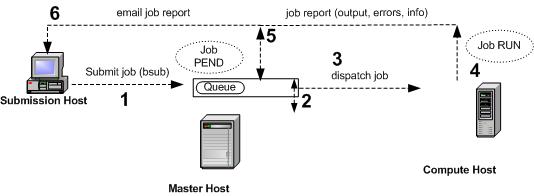Job life cycle

1. Submit a job
You submit a job from an LSF client or server with the bsub command.
If you do not specify a queue when submitting the job, the job is submitted to the default queue.
Jobs are held in a queue waiting to be scheduled and have the PEND state. The job is held in a job file in the LSF_SHAREDIR/cluster_name/logdir/info/ directory, or in one of its subdirectories if MAX_INFO_DIRS is defined in the configuration file lsb.params.
Job ID: LSF assigns each job a unique job ID when you submit the job.
Job name: You can also assign an arbitrary name to the job with the -J option of bsub. Unlike the job ID, the job name is not necessarily unique.
2. Schedule the job
The master batch daemon (mbatchd) looks at jobs in the queue and sends the jobs for scheduling to the master batch scheduler (mbschd) at a preset time interval (defined by the parameter JOB_SCHEDULING_INTERVAL in the configuration file lsb.params).
mbschd evaluates jobs and makes scheduling decisions based on:
Job priority
Scheduling policies
Available resources
mbschd selects the best hosts where the job can run and sends its decisions back to mbatchd.
Resource information is collected at preset time intervals by the master load information manager (LIM) from LIMs on server hosts. The master LIM communicates this information to mbatchd, which in turn communicates it to mbschd to support scheduling decisions.
3. Dispatch the job
As soon as mbatchd receives scheduling decisions, it immediately dispatches the jobs to hosts.
4. Run the job
Receives the request from mbatchd.
Creates a child sbatchd for the job.
Creates the execution environment.
Starts the job using a remote execution server (res).
LSF copies the execution environment from the submission host to the execution host and includes the following:
Environment variables needed by the job
Working directory where the job begins running
Other system-dependent environment settings, for example:
On UNIX and Linux, resource limits and umask
On Windows, desktop and Windows root directory
The job runs under the user account that submitted the job and has the status RUN.
5. Return output
When a job is completed, it is assigned the DONE status if the job was completed without any problems. The job is assigned the EXIT status if errors prevented the job from completing.
sbatchd communicates job information including errors and output to mbatchd.
6. Send email to client
mbatchd returns the job output, job error, and job information to the submission host through email. Use the -o and -e options of bsub to send job output and errors to a file.
Job report: A job report is sent by email to the LSF client and includes:
Job information:
CPU use
Memory use
Name of the account that submitted the job
Job output
Errors